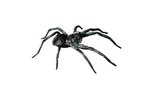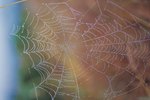
Spiders often inspire fear and have a bad reputation, but they're actually beneficial predators that control pest populations around homes and in gardens. All spiders produce silk, but not all of them use that silk to make webs for catching prey. Among web-building spiders, different families spin their webs in different patterns. By looking at the shape and structure of a spider web, you usually can determine the type of spider that built it.
Wheel in the Sky
Orb weaver spiders belong to the Araneidae family and spin large, vertical webs that spiral outward on thin strands like spokes on a wheel. While orb webs are beautiful, they're also fairly high-maintenance -- the spiders have to repair their webs at least once a day. These webs are most common in gardens and fields and are rarely seen indoors. The spiders that weave them have large, irregularly shaped abdomens and often are brightly colored. Some of the most common orb weavers in the United States are the barn spiders. Yellow and brown in coloration, they served as E. B. White's inspiration for Charlotte in his book "Charlotte's Web."
All the Right Angles
Spiders in the Uloboridae family spin triangle-shaped webs that look as though a slice were removed from an orb spider's round web. Their method of construction differs from orb weavers, however. These spiders build their webs horizontally rather than vertically. Uloborids are the only family of spiders without venom glands, and the webs they build reflect this. Also known as hackled orb weavers, their webs aren't sticky. The silk these spiders produce is fuzzy, with each strand covered in tiny fibers that catch and tangle prey. Since their bites are ineffective, hackled orb weavers wrap web intruders tightly in the woolly silk, smothering their prey.
Funnel of Doom
If you see a dense web wrapped in a funnel shape, it was made by a member of the Agelenidae family. These spiders typically build their webs low to the ground, around stairs or under low shrubs, although they're also fairly common around buildings, in closets and other low-traffic areas. Funnel spiders' webs are permanent and, unless seriously disturbed, they live in the same webs their entire lives, making the webs larger as they grow. Spiders usually are solitary creatures, but there are social species of funnel spiders in Africa that live together in large communal webs.
What Tangled Webs We Weave
If you've decorated for Halloween, you're familiar with cob webs -- small, random messes of silk, attached by long strings to anything solid. These webs are made by small spiders that are members of the Theridiidae family, such as the common house spider. Mesh webs, made by Dictynidae family members, are similar to cob webs, although their construction is a little more organized and consistent. Both types of spiders typically hang upside down in their webs. Cob webs are common in and around buildings and homes, while mesh webs are more likely to be found out in nature, on plants, under stones or in leaves.
Smoothing the Sheets
The Linyphiidae family of sheet web spiders all make their webs in the same way, but they take many different forms. Interwoven sheets of silk create shapes that resemble flat platforms, bowls or domes. Several spiders known as bowl and doily spiders spin a web that appears to be a bowl resting on an intricate doily, for example. Compared to delicate orb webs, these webs may look somewhat messy. However, they have tight, dense weaves without many gaps and are effective at booby-trapping unsuspecting insects.
References
- University of Michigan BioKIDS: Kids' Inquiry of Diverse Species, Webs and Cocoons
- The Field Museum Division of Environment, Culture and Conservation: Common Spiders of the Chicago Region
- University of Minnesota Extension: Common Spiders In and Around Homes
- University of Michigan BioKIDS: Orb Weavers
- University of Michigan BioKIDS: Hackled Orb Weavers
- University of Michigan BioKIDS: Funnel Weavers
Photo Credits
-
yanikap/iStock/Getty Images
Writer Bio
Jennifer Mueller began writing and editing professionally in 1995, when she became sports editor of her university's newspaper while also writing a bi-monthly general interest column for an independent tourist publication. Mueller holds a Bachelor of Arts in political science from the University of North Carolina at Asheville and a Juris Doctor from Indiana University Maurer School of Law.



